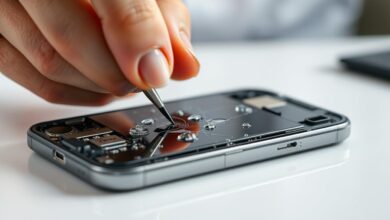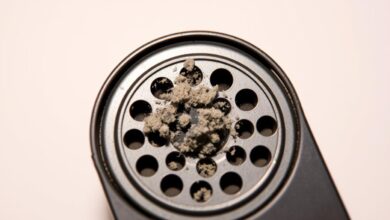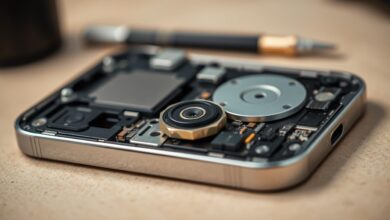how to clean phone speaker
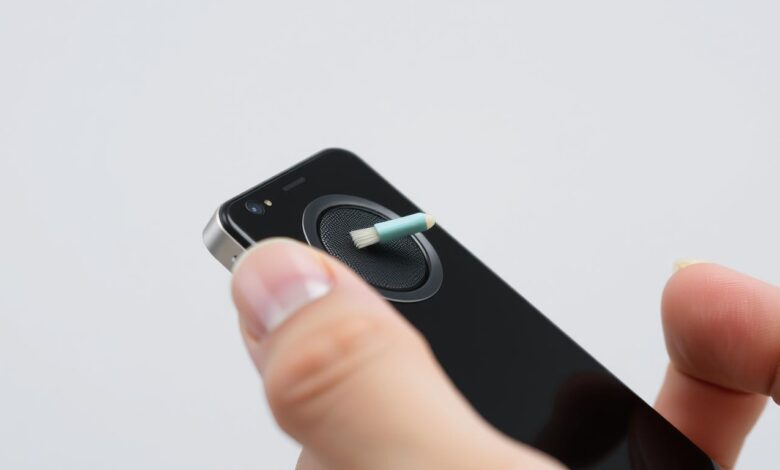
Keeping your phone’s audio performance top-notch is key for a great user experience. Dust and dirt can build up in the speaker, messing with sound quality. This guide will show you how to get your phone’s speaker back in top shape.
Cleaning your phone speaker is easy and can be done at home. Just a few simple steps can remove dust and debris and boost your phone’s sound.
Key Takeaways
- Regularly cleaning your phone speaker can improve audio performance.
- Dust and debris accumulation can affect sound quality.
- Cleaning your phone speaker is a simple process that can be done at home.
- Following a few easy steps can help restore your phone’s speaker to its optimal state.
- A clean phone speaker can enhance your overall user experience.
Understanding Phone Speaker Systems
Smartphone speakers come in many designs. Knowing your device’s specifics is key for good maintenance. Modern phones have various speakers, each with its own needs and cleaning methods.
Different Speaker Types in Modern Smartphones
Smartphones have mono, stereo, and advanced acoustic speakers. Mono speakers give one audio channel. Stereo speakers offer two channels for a better sound experience. Advanced acoustic speakers use new tech to improve sound quality. Knowing your phone’s speaker type is vital for cleaning and care.
How Speaker Design Affects Cleaning Approach
The design of your phone’s speaker affects how you clean it. For example, speakers with grill designs need different tools than those with mesh or perforated covers. Choosing the right cleaning method helps avoid damage to the speaker. A top phone maker says, “The right cleaning can make your speaker last longer.”
Why Phone Speakers Get Dirty
It’s important to know why phone speakers get dirty to keep sound quality good. Phone speakers face many environmental factors and usage patterns. These can cause blockages and impact sound.
Environmental Factors: Dust, Lint, and Debris
Environmental factors greatly contribute to dirtying phone speakers. Dust, lint, and debris can build up in the speaker grills, lowering sound quality. These particles come from air, clothing, and nearby surfaces.
- Dust particles suspended in the air
- Lint from clothing or fabric
- Debris from nearby objects or surfaces
Impact of Daily Usage Patterns
Daily activities also play a part in dirtying phone speakers. Putting the phone on dusty surfaces or handling it in dirty environments makes it worse. Frequent handling can also bring oils and dirt from hands into the speaker grills.
How Pocket Storage Contributes to Speaker Blockage
Storing phones in pockets can lead to speaker blockage. Pockets collect lint, dust, and other debris, which can then get on the phone’s speaker grills. Cleaning pockets or using a phone case with a grill cover can help prevent this.
Signs Your Phone Speaker Needs Cleaning
Knowing when your phone speaker needs cleaning can prevent annoying audio issues. A dirty speaker can cause many problems that ruin your experience.
Audio Quality Issues and Distortion
If your audio sounds distorted or not as good as before, it might be dirty. This can cause crackling, fuzzy sounds, or unclear music and calls. Cleaning your speaker regularly helps keep the sound clear.
Volume Inconsistencies and Muffled Sound
A dirty speaker can make volume changes or sound muffled. This is a big problem for calls and music. If your volume keeps changing or sounds dull, it’s time to clean. Remember, a clean speaker means better sound.
Call Quality Problems Related to Speaker Blockage
Dirty speakers can also mess up call quality, making it hard for others to hear you. If people often say you’re hard to hear, or you can’t hear them well, it’s likely a blockage. Cleaning your speaker fixes these problems and ensures clear calls.
By watching for these signs and cleaning your speaker, you can keep your phone’s sound quality high. Regular cleaning is essential for enjoying clear, sharp sound from your device.
Essential Tools for Cleaning Phone Speakers
To keep your phone’s audio quality top-notch, you’ll need the right cleaning tools. Cleaning your phone speaker is easy with the right equipment.
Professional Cleaning Supplies
For a deep clean, use professional cleaning supplies. Compressed air is great for blowing out dust and debris from the speaker grills. A soft-bristled brush helps gently sweep away particles.
For tough dirt, a specialized phone cleaning kit is needed. It usually has various brushes and cleaning solutions.
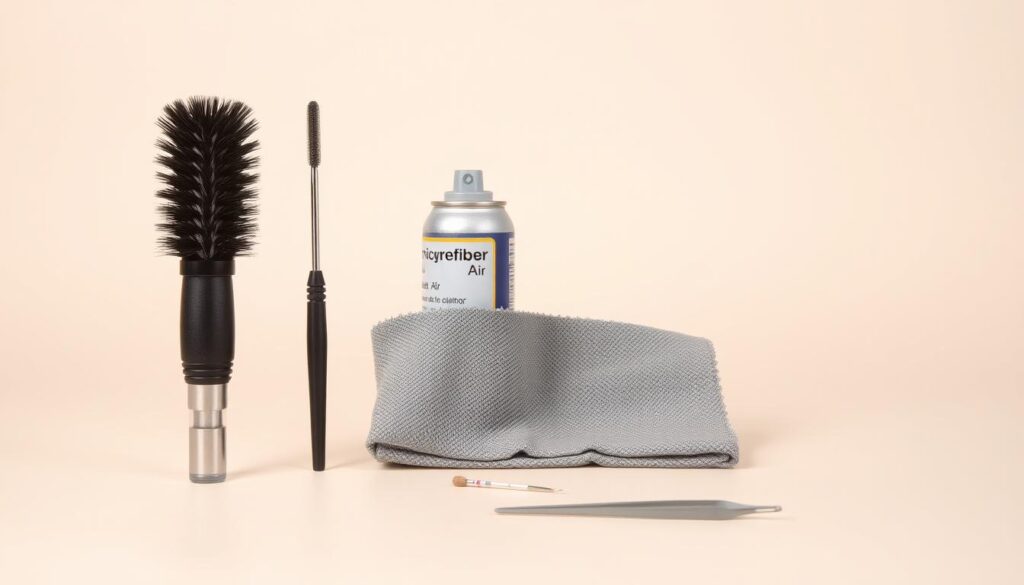
| Tool | Description | Effectiveness |
|---|---|---|
| Compressed Air | Blows out dust and debris | High |
| Soft-bristled Brush | Gently sweeps away particles | Medium |
| Phone Cleaning Kit | Includes various brushes and cleaning solutions | High |
Household Items That Work Effectively
If you don’t have professional cleaning supplies, household items can work well. A dry toothbrush can gently brush away debris from the speaker grills. Adhesive putty or masking tape can pick up dust and lint.
For a deeper clean, use a microfiber cloth slightly dampened with water. It can wipe down the speaker area.
Precautions Before You Begin Cleaning
Before you start cleaning your phone’s speaker, it’s important to take precautions. Cleaning your phone’s speaker can be delicate. It’s crucial to protect your device from damage.
Protecting Your Device from Damage
To keep your device safe, make sure to power it off before cleaning. This stops any accidental damage from happening. Also, take out any SIM cards, SD cards, or other external components to avoid damage to them.
Choosing the right tools is key. Don’t use sharp objects or abrasive materials that could harm your phone. Instead, use soft-bristled brushes or canned compressed air made for electronics.
Materials and Substances to Avoid
Some materials and substances can harm your phone’s speaker or other parts. Avoid using liquids unless the manufacturer says it’s okay. Liquids can damage your device. Also, stay away from chemical cleaners or abrasive powders as they can corrode or scratch your phone.
When it comes to smartphone speaker maintenance, don’t use household items not made for electronics. For the best ways to clean phone speaker, use tools and materials made for cleaning electronics. This ensures a safe and effective clean.
How to Clean Phone Speaker Using Compressed Air
Cleaning your phone speaker with compressed air is easy and works well. It helps get rid of dust, lint, and other stuff that might mess up your sound.
Step-by-Step Air Blasting Technique
To clean your phone speaker with compressed air, just follow these steps:
- First, make sure your phone is off to avoid damage or shock.
- Hold the can of compressed air upright and shake it gently before you start.
- Then, spray the air into the speaker grills in short, controlled bursts.
- Move the can around the speaker area to get debris from all sides.
Optimal Pressure and Distance Control
It’s important to control the air pressure and distance to avoid harm. Keep the can at least 6 inches away from the speaker grill. Use short bursts of air. This way, you avoid pushing debris deeper into the speaker or causing damage with strong air streams.
| Precaution | Benefit |
|---|---|
| Holding the can upright | Prevents liquid from entering the can and potentially damaging your phone |
| Using short bursts of air | Reduces the risk of pushing debris further into the speaker |
| Maintaining a safe distance | Prevents damage from high-pressure air streams |
By following these tips and using compressed air right, you can clean your phone speaker well. This will make your sound better.
Soft Brush Cleaning Methods for Phone Speakers
A soft brush is a great tool for cleaning your phone’s speaker. It’s gentle and effective, using tools you likely have. It helps remove dust and debris that can block the speaker’s sound.
Selecting the Appropriate Brush Type
Choosing the right brush is key for cleaning your phone’s speaker. Choose a brush with soft bristles to avoid scratching the speaker grill. A small, dry paintbrush or makeup brush works well.
The bristles should be soft but still effective at removing debris. This way, you can clean without damaging your phone.
- Look for brushes with synthetic or natural fibers that are soft to the touch.
- Avoid using brushes with hard bristles or metal parts that could potentially damage your phone.
- Consider a brush specifically designed for electronics or delicate surfaces.
Proper Brushing Technique to Avoid Damage
To clean your phone speaker with a soft brush, use the right technique. Gently sweep the brush across the speaker grill to loosen and remove debris. Don’t press too hard, as it could push debris further or damage the grill.
- Hold your phone at an angle that allows you to see the speaker grill clearly.
- Gently brush the speaker grill in one direction to avoid pushing debris around.
- Inspect the speaker grill after brushing to see if further cleaning is needed.
By following these steps and using the right brush, you can keep your smartphone’s speaker in top shape. This ensures great sound quality and extends your speaker’s life. Regular cleaning with a soft brush is a simple yet effective phone speaker cleaning tip for smartphone speaker maintenance.
Adhesive Cleaning Techniques for Speaker Grills
Adhesive cleaning techniques are a simple and effective way to clean phone speaker grills. They are great for removing stubborn particles that can harm sound quality. We will look at how to use adhesives to clean your phone’s speaker grill well.
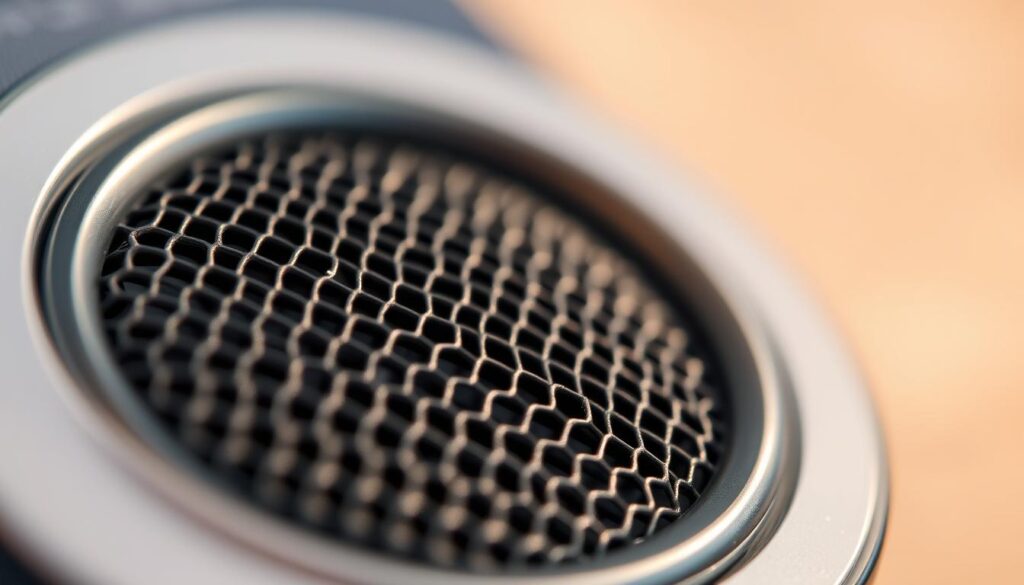
Masking Tape and Painter’s Tape Methods
Using masking tape or painter’s tape is a common and easy method. These tapes are soft on surfaces and can grab dust and debris from speaker grills. To clean, wrap tape around your finger with the sticky side out, then dab at the speaker grill.
Be gentle to avoid pushing debris deeper into the speaker. For tough particles, try a stickier tape but be careful not to harm the grill. Cleaning your speaker grill with tape regularly can keep your phone’s sound quality up.
Using Adhesive Putty for Stubborn Debris
Adhesive putty is good for tough debris. It’s often used for cleaning between keyboard keys or small crevices. For phone speaker grills, mold the putty into a small shape, then press it onto the debris.
When using putty, handle it carefully to avoid damaging the speaker. Also, check the putty for debris before using it again. This method works well for removing lint or fibers from the speaker grill.
Using Toothpicks and Small Tools Safely
Toothpicks and small tools are great for cleaning phone speakers. But, they must be used carefully. This method can be a key part of your DIY phone speaker cleaning routine.
It’s important to know how delicate phone speakers are. Modern phones have complex speakers that can break easily if mishandled.
Precision Cleaning for Speaker Openings
Choose a toothpick that’s strong enough to remove dirt but won’t harm the speaker. Carefully put the toothpick into the speaker opening. Then, gently move any stuck particles.
Be patient and careful to avoid pushing dirt deeper or damaging the inside of the speaker.
Combining Tools for Effective Results
Using toothpicks with other tools can make cleaning better. For example, use compressed air after you’ve removed big debris with a toothpick. This helps get rid of smaller particles.
A table below shows the tools and their uses:
| Tool | Use |
|---|---|
| Toothpick | Removing larger debris from speaker openings |
| Compressed Air | Dislodging finer particles |
| Soft Brush | Gently sweeping away remaining dust and debris |
By using these tools and methods, you can clean your phone’s speaker well. This will make it sound better and last longer.
Cleaning with Isopropyl Alcohol: Do’s and Don’ts
Cleaning your phone’s speakers with isopropyl alcohol needs care to avoid harm. It’s good for removing dirt but use it wisely.
Safe Application Methods
To clean your phone’s speaker safely, dampen a soft cloth or cotton swab with alcohol. Don’t soak it, as too much water can harm the speaker. Gently wipe the grills and around them, being careful not to push dirt in.
For a deeper clean, check out a phone speaker cleaning guide that uses isopropyl alcohol and other methods.
Don’t spray alcohol directly on the speaker or into your phone. Apply it to the cloth or swab first. This way, you control how much alcohol touches your phone’s speaker.
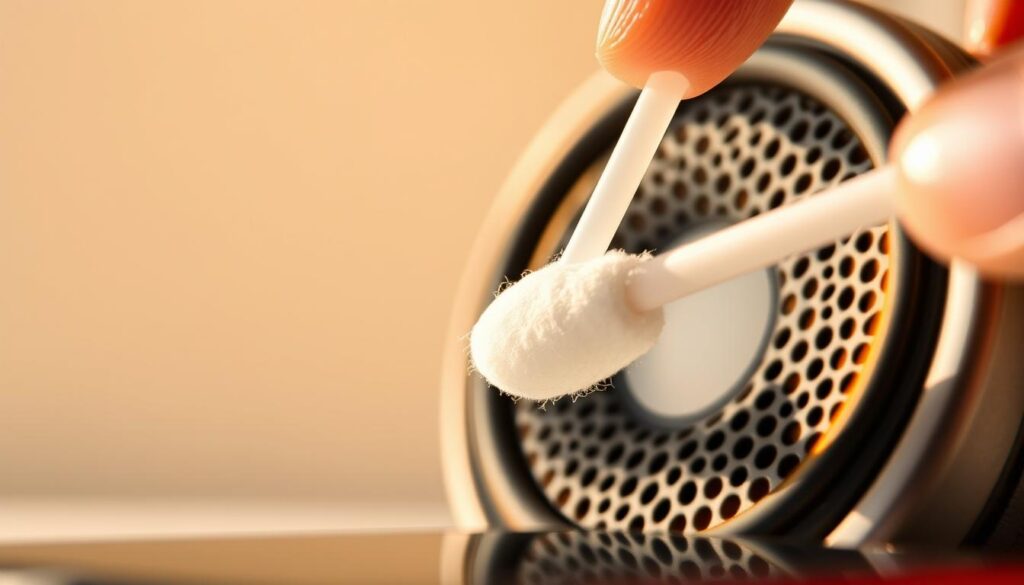
Concentration Levels and Drying Procedures
Use isopropyl alcohol that’s 70% or less for cleaning. Stronger solutions can harm the speaker. After cleaning, let it air dry fully before testing the speaker. This ensures no moisture damage.
For good smartphone speaker maintenance, let the alcohol dry completely. Don’t use heat to dry it faster, as it can damage your phone’s parts.
iPhone-Specific Speaker Cleaning Techniques
Cleaning your iPhone’s speaker is easy with the right methods. These techniques help keep your device’s sound system in top shape.
Addressing Lightning Port and Speaker Grills
Cleaning your iPhone’s speaker means focusing on the Lightning port and speaker grills. These areas often get dusty, which can mess with your sound.
- Use a soft-bristled brush to gently sweep away debris from the speaker grills.
- For the Lightning port, use a small, dry brush or a specialized cleaning tool to remove dust and lint.
Apple’s Official Cleaning Recommendations
Apple has its own tips for cleaning iPhone speakers. They say to stay away from liquids and not put things into the speaker grills.
Key Recommendations:
- Avoid using liquids or cleaning products.
- Don’t insert objects into the speaker grills.
- Use a soft, dry cloth to gently wipe the exterior.
By sticking to these tips, you can keep your iPhone’s speaker clean and sound great.
Android Phone Speaker Maintenance Strategies
Keeping your Android device’s speaker quality high is key for a great user experience. Android phones pick up dust, lint, and debris, which can mess with sound quality. Regular care is vital to avoid these problems.
Effective speaker maintenance boosts sound quality and extends your device’s life. We’ll look at ways to keep Android phone speakers clean, covering specific tips for different brands and general cleaning methods.
Brand-Specific Considerations (Samsung, Google, OnePlus)
Each Android brand has its own design that impacts how you clean the speakers. Samsung phones have a special speaker grill that needs careful cleaning to avoid pushing dirt in. Google Pixel phones, with their simple design, have speakers in unique spots that need attention. OnePlus phones, known for their sleek look, might get dusty easily because of their design.
When cleaning Samsung phones, be gentle around the speaker grills to avoid damage. For Google Pixel phones, a soft-bristled brush works well to clean out debris. OnePlus users might find compressed air helpful for getting dust out of speaker openings.
Universal Android Speaker Cleaning Methods
There are cleaning methods that work for all Android brands. A soft-bristled toothbrush or an electronics brush is good for gently removing dirt from speaker grills. Compressed air is also useful for blowing out dust and lint from speaker openings. For tough dirt, a small piece of adhesive putty can pick it up without harming the speaker.
To keep your Android phone’s speaker in top shape, clean it often, especially if you use it in dusty places. By adding these best ways to clean phone speaker to your routine, you’ll keep sound quality high and your device lasting longer.
Preventative Measures to Keep Speakers Clean
To keep your phone speaker in top shape, take some preventative steps. These steps will help you clean less often and keep your sound quality high.
Protective Cases and Screen Protectors
Protective cases and screen protectors can block out dust and debris. Choose cases with precise cutouts to avoid blocking the speaker. Also, a screen protector can stop dust and dirt from reaching the speaker.
A quality protective case can shield your speaker from the environment. When picking a case, think about the material and design. Make sure it doesn’t harm the speaker’s sound.
| Case Type | Benefits | Drawbacks |
|---|---|---|
| Silicone Cases | Flexible, shock-absorbing | May attract dust |
| Hard Plastic Cases | Durable, precise cutouts | May scratch easily |
| Wallet Cases | Multi-functional, card storage | May be bulky |
Regular Maintenance Schedule
Having a regular maintenance plan is key for a clean phone speaker. Clean your speaker at least once a month to avoid blockages. You can also clean it when you update your phone or back up your data.
Sticking to a maintenance schedule keeps your speaker working well. This way, you can catch any problems early and fix them before they get worse.
Conclusion
Cleaning your phone speaker is easy with the right tools and techniques. This guide shows you how to do it. By cleaning regularly, you keep your phone’s sound quality high.
It’s smart to clean your phone speaker often, especially if you hear bad sound. Check out our guide on cleaning your phone for more tips. It helps keep your device clean and working well.
Adding these simple steps to your routine will make your phone’s audio better. You’ll enjoy clear sound and a better phone experience.
FAQ
How often should I clean my phone speaker?
Clean your phone speaker every few months. Do it more often if you see a drop in sound quality or have been in dusty places.
Can I use water to clean my phone speaker?
No, don’t use water. It can harm the inside parts. Instead, use compressed air or a soft brush to clean.
What is the best way to clean the speaker grill on my phone?
Use adhesive cleaning like masking tape or painter’s tape for the grill. For tough dirt, try adhesive putty.
Can I use a regular household brush to clean my phone speaker?
A soft-bristled brush is okay, but a special soft brush is better. It helps avoid damage and pushes dirt out.
Is it safe to use isopropyl alcohol to clean my phone speaker?
Yes, isopropyl alcohol works, but use it carefully. Follow safe methods, right concentration, and dry it well to protect your device.
How can I prevent my phone speaker from getting dirty in the future?
Use a protective case and screen protector. Also, clean regularly to stop blockages.
Are there any specific cleaning techniques for my iPhone or Android device?
Yes, I have tips for iPhone and Android. For iPhone, clean the Lightning port and grills. Follow Apple’s advice. For Android, consider the brand and use universal methods.
